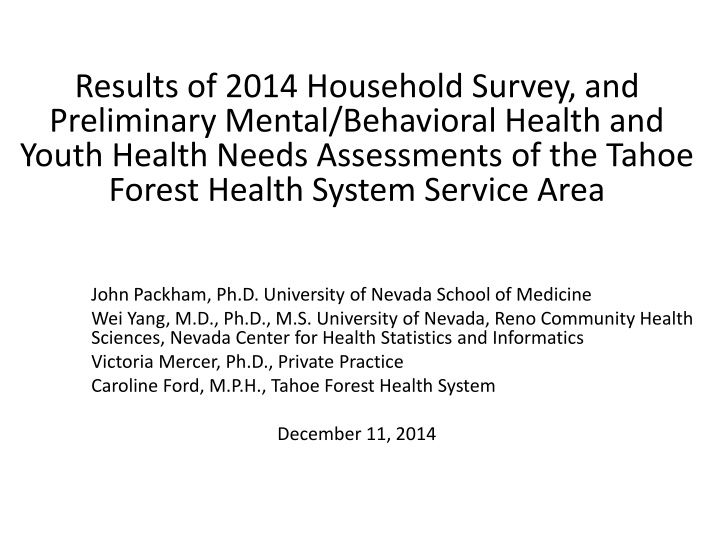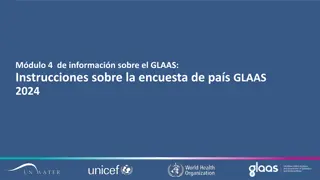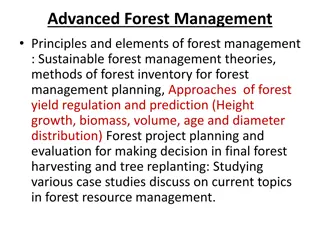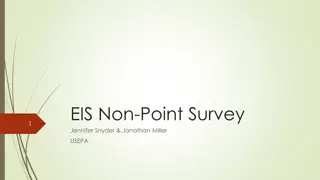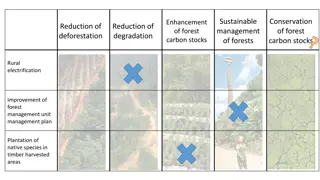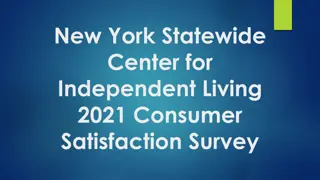2014 Household Survey & Health Needs Assessment in Tahoe Forest Health System Service Area
The 2014 Household Survey and Preliminary Mental/Behavioral Health & Youth Health Needs Assessments were conducted in the Tahoe Forest Health System Service Area. The surveys gathered data on various socio-demographic factors, health statuses, and general well-being perceptions. Results indicate insights into community health trends and areas for potential health interventions.
Download Presentation

Please find below an Image/Link to download the presentation.
The content on the website is provided AS IS for your information and personal use only. It may not be sold, licensed, or shared on other websites without obtaining consent from the author.If you encounter any issues during the download, it is possible that the publisher has removed the file from their server.
You are allowed to download the files provided on this website for personal or commercial use, subject to the condition that they are used lawfully. All files are the property of their respective owners.
The content on the website is provided AS IS for your information and personal use only. It may not be sold, licensed, or shared on other websites without obtaining consent from the author.
E N D
Presentation Transcript
Results of 2014 Household Survey, and Preliminary Mental/Behavioral Health and Youth Health Needs Assessments of the Tahoe Forest Health System Service Area John Packham, Ph.D. University of Nevada School of Medicine Wei Yang, M.D., Ph.D., M.S. University of Nevada, Reno Community Health Sciences, Nevada Center for Health Statistics and Informatics Victoria Mercer, Ph.D., Private Practice Caroline Ford, M.P.H., Tahoe Forest Health System December 11, 2014
Overview of Household Survey 402 surveys completed between July 10 and August 4, 2014 68% completed by phone, 32% on-line Final data have been are weighted to adjust for the age, gender, and racial and ethic distribution of the sample versus Census Bureau estimates of population characteristics 2
Overview of Household Survey Maximum statistical margin of error for the sample-wide results (N=402) is approximately +/- 4.9% at the 95 percent confidence interval Numerous questions benchmarked against data from the 2011 TFHS household survey (N=457) Total percentages for many questions do not equal 100.0% due to rounding and respondents who indicated that they were not sure or prefer to not to answer 3
Responses by Socio-demographic Factors and Characteristics Age (Q4) Education (Q78) Employment Status (Q7) Gender (Q3) Income (Q80) Marital Status (Q79) Race & Ethnicity (Q5, Q6) Region-Community (Q2) 4
Would you say that in general your health is _____ ? (Q8) 38.2% 40.0% 34.2% 30.0% 18.2% 20.0% 10.0% 6.3% 2.0% 0.0% Excellent Very good Good Fair Poor N = 402 6
Would you say that in general your health is _____ ? (Q8) 40.0% 38.2% 34.2% 33.3% 31.8% 30.0% 21.8% 20.0% 18.2% 10.7% 10.0% 6.3% 2.4% 2.0% 0.0% Excellent Very Good Good Fair Poor 2011 2014 7
Would you say that in general your health is _____ ? (Q8) 40.0% 38.2% 34.2% 30.5% 30.4% 30.0% 20.2% 20.0% 18.2% 14.4% 10.0% 6.3% 4.6% 2.0% 0.0% Excellent Very Good Good Fair Poor California (2013) TFHS (2014) 8
How many days during the past 30 days was your physical health not good? (Q9) 80.0% 69.5% 60.4% 60.0% 40.0% 27.8% 19.8% 20.0% 9.3% 5.7% 3.2% 2.5% 0.0% None 1 to 7 days 8 to 14 days 15 to 30 days 2011 2014 9
How many days during the past 30 days was your physical health not good? (Q9) 12.0% 10.9% 10.7% 10.0% 8.0% 5.7% 6.0% 4.0% 2.0% 0.0% Precent reporting 15 to 30 days TFHS (2014) CA (2013) US (2013) 10
How many days during the past 30 days was your physical health not good? (Q9) 40.0% 35.1% 30.0% 20.0% 11.0% 8.1% 10.0% 7.0% 3.8% 0.0% Percent reporting 15 to 30 days Employed Self-Employed Unemployed Homemaker Retired N=388 11
How many days during the past 30 days was your mental health not good? (Q10) 80.0% 65.9% 60.0% 40.0% 20.0% 11.1% 10.0% 8.5% 2.3% 0.0% None 1 to 3 days 4 to 7 days 8 to 14 days 15 to 30 days N=402 12
How many days during the past 30 days was your mental health not good? (Q10) 80.0% 67.9% 65.9% 60.0% 40.0% 21.1% 19.7% 20.0% 8.5% 7.9% 4.4% 2.3% 0.0% None 1 to 7 days 8 to 14 days 15 to 30 days 2011 2014 13
How many days during the past 30 days was your mental health not good? (Q10) 12.0% 10.9% 10.7% 10.0% 8.5% 8.0% 6.0% 4.0% 2.0% 0.0% Percent reporting 15 to 30 days TFHS (2014) CA (2013) US (2013) 14
How many days during the past 30 days was your mental health not good? (Q10) 30.0% 27.2% 19.3% 20.0% 12.2% 8.7% 10.0% 5.4% 0.0% Percent reporting 15 to 30 days Employed Self-Employed Unemployed Homemaker Retired N=388 15
How often do you get the social and emotional support you need? Would it be _____ ? (Q11) 60.0% 51.6% 43.8% 40.0% 31.6% 28.7% 20.0% 12.8% 11.5% 5.6% 5.2% 3.7% 3.2% 0.0% Always Usually Sometimes Rarely Never 2011 2014 16
How often do you get the social and emotional support you need? Would it be _____ ? (Q11) 12.0% 10.8% 10.0% 7.8% 8.0% 6.0% 4.0% 2.0% 0.0% Percent reporting "Rarely" or "Never" TFHS (2014) US (2013) 17
How many times per week do you prepare and eat a family meal in your household? (Q12) 80.0% 73.4% 62.1% 60.0% 40.0% 18.8% 20.0% 13.2% 9.6% 5.1% 5.0% 1.8% 0.0% Never 1 to 3 times 4 to 7 times 8 times or more 2011 2014 19
During the past month, how many times did you eat fruit? (Q13) 11% 20% 15% 54% 15 times or less 31 to 60 times 16 to 30 times More than 60 times N = 402 20
During the past month, how many times did you eat vegetables? (Q14) 5% 20% 23% 52% 15 times or less 16 to 30 times 31 to 60 times More than 60 times N = 402 21
During the past 12 months, have you had either a flu shot or a flu vaccine that was sprayed in your nose? (Q15) 80.0% 80.0% 66.4% 62.8% 61.5% 63.0% 60.9% 60.0% 60.0% 39.1% 40.0% 40.0% 36.2% 20.0% 20.0% 0.0% 0.0% Yes No Percent reporting "Yes" TFHS (2014) CA (2013) US (2013) 2011 2014 23
Have you ever had the adult booster for the Tdap (Tetanus, diphtheria and pertussis) vaccine? (Q16) 60.0% 48.6% 50.0% 40.0% 36.8% 30.0% 20.0% 14.6% 10.0% 0.0% Yes No Not Sure 24
A mammogram is an x-ray of each breast to look for breast cancer. Have you ever had a mammogram? (Q17) 80.0% 80.0% 68.4% 66.4% 66.4% 60.9% 60.0% 60.0% 39.1% 40.0% 40.0% 33.6% 20.0% 20.0% 0.0% 0.0% Yes No Percent reporting "No" TFHS (2014) US (2013) 2011 2014 26
A mammogram is an x-ray of each breast to look for breast cancer. Have you ever had a mammogram? (Q17) 100.0% 76.6% 80.0% 66.4% 55.8% 60.0% 48.5% 40.0% 20.0% 0.0% Percent reporting "Yes" Entire Sample High School or Less College 1 to 3 Years College 4+ Years N = 213 (33) (61) (119) 27
A mammogram is an x-ray of each breast to look for breast cancer. Have you ever had a mammogram? (Q17) Females age 40 and Over 100.0% 93.7% 90.9% 80.0% 60.0% 40.0% 20.0% 9.1% 6.3% 0.0% Yes No 2011 2014 28
How long has it been since you had your last mammogram? (Q18) 80.0% 62.6% 60.0% 52.6% 40.0% 21.9% 18.5% 20.0% 11.7% 8.4% 7.9% 5.9% 5.5% 4.6% 0.0% Within past year Within past 2 years Within past 3 years Within past 5 years 5 years or more 2011 2014 29
Sigmoidoscopy and colonoscopy are exams in which a tube is inserted in the rectum to view the colon for signs of cancer or other health problems. Have you had either of these exams? (Q19) 80.0% 80.0% 74.2% 70.3% 69.0% 70.3% 60.0% 60.0% 40.0% 40.0% 28.2% 25.8% 20.0% 20.0% 0.0% 0.0% Percent reporting "Yes" Yes No TFHS (2014) US (2013) 2011 2014 30
Sigmoidoscopy and colonoscopy are exams in which a tube is inserted in the rectum to view the colon for signs of cancer or other health problems. Have you had either of these exams? (Q19) 80.0% 72.0% 57.0% 60.0% 43.0% 40.0% 26.7% 20.0% 0.0% Yes No Hispanic/Latino (N=18) Not Hispanic/Latino (N=151) 31
Why have you not had either of these exams? (Sigmoidoscopy or colonoscopy) (Q20) 60.0% 49.0% 40.0% 19.9% 20.0% 12.3% 8.0% 7.7% 3.1% 0.0% Cost Lack of insurance Do not have, know a doctor No reason Don't know, Prefer not to answer not sure N=48 32
A Pap test is a test for cancer of the cervix. Have you ever had a Pap test? (Q21) 94.0% 100.0% 97.5% 92.8% 92.8% 92.0% 75.0% 90.0% 50.0% 89.0% 88.0% 25.0% 7.2% 2.5% 86.0% 0.0% Percent reporting "Yes" Yes No TFHS (2014) US (2013) 2011 2014 33
Have you ever been told by a doctor, nurse, or other health professional that you have high blood pressure? (Q22) 40.0% 31.4% 28.7% 30.0% 25.5% 20.0% 10.0% 0.0% Percent reporting "Yes" TFHS (2014) CA(2013) US (2013) 34
About how long has it been since you last had your blood cholesterol checked? (Q23) 11% 9% 4% 6% 58% 12% Within past year Within past 2 years Within past 3 years Within past 5 years 5 years or more Don't know/not sure N=402 35
Has a doctor, nurse or other health professional ever told you that your blood cholesterol is high? (Q24) 80.0% 75.6% 60.0% 40.0% 24.4% 20.0% 0.0% Yes No 36
Has a doctor, nurse or other health professional ever told you that you have angina or coronary heart disease? (Q25) 100.0% 96.9% 80.0% 60.0% 40.0% 20.0% 3.1% 0.0% Yes No 37
During the past 30 days, have you had at least one drink of any alcoholic beverage, such as beer, wine, a malt beverage, or liquor (Q26) 100.0% 100.0% 81.1% 81.1% 80.0% 76.7% 80.0% 55.5% 60.0% 54.5% 60.0% 40.0% 40.0% 23.3% 18.6% 20.0% 20.0% 0.0% 0.0% Percent reporting "Yes" Yes No TFHS (2014) CA (2013) US (2013) 2011 2014 39
During the past 30 days, have you had at least one drink of any alcoholic beverage, such as beer, wine, a malt beverage, or liquor (Q26) 100.0% 92.0% 81.1% 80.0% 71.2% 63.2% 60.0% 40.0% 20.0% 0.0% Percent reporting "Yes" Entire Sample N=402 (60) (106) (215) High School or Less College 1 to 3 Years College 4+ Years 40
During the past 30 days, have you had at least one drink of any alcoholic beverage, such as beer, wine, a malt beverage, or liquor (Q26) 100.0% 84.2% 80.0% 67.2% 60.0% 40.0% 32.8% 15.4% 20.0% 0.0% Yes No Hispanic/Latino (N=73) Not Hispanic/Latino (N=328) 41
During the past 30 days, on the days you drank, about how many drinks did you have on average? (Q27) Respondents who drank an alcoholic beverage in the past 30 days 80.0% 71.5% 60.0% 40.0% 20.2% 20.0% 7.0% 0.0% 1 to 2 drinks 3 to 5 drinks 6 or more drinks N=326 42
During the past 30 days, on the days you drank, about how many drinks did you have on average? (Q27) Respondents who drank an alcoholic beverage in the past 30 days 60.0% 50.8% 49.2% 41.6% 40.0% 36.7% 20.0% 7.1% 7.0% 5.6% 2.0% 0.0% 1 drink 2 to 3 drinks 4 to 5 drinks 6 or more drinks 2011 2014 43
During the past 30 days, how many days per week or month did you have at least one drink of any alcoholic beverage? (Q28) Respondents who drank an alcoholic beverage in the past 30 days 40.0% 35.0% 35.0% 30.0% 26.9% 25.0% 18.9% 18.6% 20.0% 15.0% 10.0% 5.0% 0.0% Less than 7 days 7 to 14 days 15 to 21 days More than 21 days N=326 44
Considering all types of alcoholic beverages, how many times during the past 30 days did you have five/four (males/females) drinks? (Q29) Respondents who drank an alcoholic beverage in the past 30 days 80.0% 70.3% 68.0% 70.0% 60.0% 50.0% 40.0% 30.0% 20.0% 16.2% 12.0% 10.9% 7.3% 10.0% 6.7% 6.7% 0.0% None Once Twice 3 or more times 2011 2014 45
Considering all types of alcoholic beverages, how many times during the past 30 days did you have five/four (males/females) drinks? (Q29) Respondents who drank an alcoholic beverage in the past 30 days 35.0% 80.0% 30.2% 70.3% 68.0% 30.0% 70.0% 60.0% 25.0% 50.0% 20.0% 17.4% 16.8% 40.0% 15.0% 30.2% 29.7% 30.0% 10.0% 20.0% 5.0% 10.0% 0.0% 0.0% Percent reporting 1 or more times None 1 or more times TFHS (2014) CA (2013) US (2013) 2011 2014 46
Have you smoked at least 100 cigarettes in your lifetime (Q30) 50.0% 80.0% 42.3% 66.8% 65.9% 40.0% 35.6% 60.0% 33.7% 30.0% 40.0% 33.7% 33.2% 20.0% 20.0% 10.0% 0.0% 0.0% Percent reporting "Yes" Yes No TFHS (2014) CA (2013) US (2013) 2011 2014 48
Do you now smoke cigarettes every day, some days, or not at all? (Q31) Respondents who have smoked at least 100 cigarettes in their life 100.0% 81.0% 77.1% 80.0% 60.0% 40.0% 20.0% 15.4% 11.1% 7.9% 7.5% 0.0% Not at all Some days Every day 2011 2014 49
Do you now smoke cigarettes every day, some days, or not at all? (Q31) Respondents who have smoked at least 100 cigarettes in their life 30.0% 22.9% 19.0% 20.0% 12.5% 10.0% 0.0% Percent reporting "Some days" or "Every day" TFHS (2014) CA (2013) US (2013) 50
